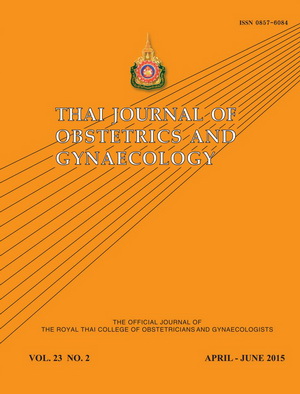Factors Associated with Shoulder Dystocia
Main Article Content
Abstract
Objective: To evaluate the factors associated with occurrence of shoulder dystocia.
Materials and Methods: A case-control study, 67 pregnant women with shoulder dystocia between January 1st, 2009 and December 31st, 2013 and match 201 cases in control group by gestational age were analyzed. The factors that were thought to associate with shoulder dystocia were collected. Multivariate logistic regression analysis was performed to predict the factors.
Results: There were 15,200 singleton delivered vaginally during that period. The incidence rate of shoulder dystocia was 0.44%. Intrapartum risk factors of shoulder dystocia were assisted vaginal delivery; the adjusted odds ratio (AOR) was 7.16 (95% CI = 3.48 – 14.72) and delivered by obstetric residents; AOR = 3.80 (95% CI = 1.02-14.09). Only neonatal birth weight was neonatal factor that associated with shoulder dystocia and the risk increased with birth weight in direct variation. Maternal factors such as age, obesity, diabetes mellitus were not associated with risk. 27 neonates had neonatal morbidity (brachial plexus injury, clavicular fracture, neonatal death) those were observed only in shoulder dystocia group.
Conclusion: Neonatal birth weight, assisted vaginal delivery and delivered by obstetric residents were significantly associated with shoulder dystocia.

